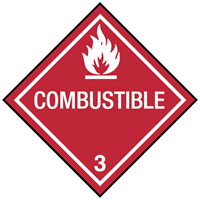
 Print
Print
Chemical Datasheet
ORANGE FLOWER WATER |

|
Chemical Identifiers
| CAS Number |
UN/NA Number |
DOT Hazard Label |
USCG CHRIS Code |
|
|
|
|
none
|
| NIOSH Pocket Guide |
International Chem Safety Card |
|
none
|
none
|
NFPA 704
data unavailable
General Description
PHYSICAL DESCRIPTION: Clear golden, fluorescent liquid with a very intense and pleasant odor. (NTP, 1992)
Hazards
Reactivity Alerts
none
Air & Water Reactions
Insoluble in water.
Fire Hazard
This chemical is probably combustible. (NTP, 1992)
Health Hazard
Excerpt from ERG Guide 128 [Flammable Liquids (Water-Immiscible)]:
CAUTION: Petroleum crude oil (UN1267) may contain TOXIC hydrogen sulphide gas. Inhalation or contact with material may irritate or burn skin and eyes. Fire may produce irritating, corrosive and/or toxic gases. Vapors may cause dizziness or asphyxiation, especially when in closed or confined areas. Runoff from fire control or dilution water may cause environmental contamination. (ERG, 2024)
Reactivity Profile
This chemical turns brown on exposure to light. (NTP, 1992)
Belongs to the Following Reactive Group(s)
- Insufficient Information for Classification
- Water and Aqueous Solutions
Potentially Incompatible Absorbents
No information available.
Response Recommendations
Isolation and Evacuation
Excerpt from ERG Guide 128 [Flammable Liquids (Water-Immiscible)]:
IMMEDIATE PRECAUTIONARY MEASURE: Isolate spill or leak area for at least 50 meters (150 feet) in all directions.
LARGE SPILL: Consider initial downwind evacuation for at least 300 meters (1000 feet).
FIRE: If tank, rail tank car or highway tank is involved in a fire, ISOLATE for 800 meters (1/2 mile) in all directions; also, consider initial evacuation for 800 meters (1/2 mile) in all directions. (ERG, 2024)
Firefighting
Fires involving this material can be controlled with a dry chemical, carbon dioxide or Halon extinguisher. (NTP, 1992)
Non-Fire Response
SMALL SPILLS AND LEAKAGE: If you spill this chemical, FIRST REMOVE ALL SOURCES OF IGNITION. Then, use absorbent paper to pick up all liquid spill material. Your contaminated clothing and absorbent paper should be sealed in a vapor-tight plastic bag for eventual disposal. Solvent wash all contaminated surfaces with 60-70% ethanol followed by washing with a soap and water solution. Do not reenter the contaminated area until the Safety Officer (or other responsible person) has verified that the area has been properly cleaned.
STORAGE PRECAUTIONS: You should protect this material from exposure to light, and store it in a refrigerator. (NTP, 1992)
Protective Clothing
RECOMMENDED RESPIRATOR: Where the neat test chemical is stored, weighed and diluted, wear an approved half face respirator equipped with an organic vapor/acid gas cartridge (specific for organic vapors, HCl, acid gas and SO2) with a dust/mist filter. (NTP, 1992)
DuPont Tychem® Suit Fabrics
No information available.
First Aid
EYES: First check the victim for contact lenses and remove if present. Flush victim's eyes with water or normal saline solution for 20 to 30 minutes while simultaneously calling a hospital or poison control center. Do not put any ointments, oils, or medication in the victim's eyes without specific instructions from a physician. IMMEDIATELY transport the victim after flushing eyes to a hospital even if no symptoms (such as redness or irritation) develop.
SKIN: IMMEDIATELY flood affected skin with water while removing and isolating all contaminated clothing. Gently wash all affected skin areas thoroughly with soap and water. If symptoms such as redness or irritation develop, IMMEDIATELY call a physician and be prepared to transport the victim to a hospital for treatment.
INHALATION: IMMEDIATELY leave the contaminated area; take deep breaths of fresh air. If symptoms (such as wheezing, coughing, shortness of breath, or burning in the mouth, throat, or chest) develop, call a physician and be prepared to transport the victim to a hospital. Provide proper respiratory protection to rescuers entering an unknown atmosphere. Whenever possible, Self-Contained Breathing Apparatus (SCBA) should be used; if not available, use a level of protection greater than or equal to that advised under Protective Clothing.
INGESTION: If the victim is conscious and not convulsing, give 1 or 2 glasses of water to dilute the chemical and IMMEDIATELY call a hospital or poison control center. Be prepared to transport the victim to a hospital if advised by a physician. If the victim is convulsing or unconscious, do not give anything by mouth, ensure that the victim's airway is open and lay the victim on his/her side with the head lower than the body. DO NOT INDUCE VOMITING. IMMEDIATELY transport the victim to a hospital. (NTP, 1992)
Physical Properties
Chemical Formula:
data unavailable
Flash Point:
greater than 200°F
(NTP, 1992)
Lower Explosive Limit (LEL): data unavailable
Upper Explosive Limit (UEL): data unavailable
Autoignition Temperature: data unavailable
Melting Point: data unavailable
Vapor Pressure: data unavailable
Vapor Density (Relative to Air): data unavailable
Specific Gravity:
0.86 to 0.88
at 77°F
(NTP, 1992)
Boiling Point: data unavailable
Molecular Weight: data unavailable
Water Solubility:
less than 1 mg/mL
at 68°F
(NTP, 1992)
Ionization Energy/Potential: data unavailable
IDLH: data unavailable
AEGLs (Acute Exposure Guideline Levels)
No AEGL information available.
ERPGs (Emergency Response Planning Guidelines)
No ERPG information available.
PACs (Protective Action Criteria)
No PAC information available.
Regulatory Information
EPA Consolidated List of Lists
No regulatory information available.
CISA Chemical Facility Anti-Terrorism Standards (CFATS)
No regulatory information available.
OSHA Process Safety Management (PSM) Standard List
No regulatory information available.
Alternate Chemical Names
- BITTER ORANGE FLOWER OIL
- CITRUS AURANTIUM AMARA FLOWER OIL
- CITRUS AURANTIUM FLOWER OIL
- CITRUS OILS, SOUR ORANGE NEROLI
- EAU D'ORANGER
- ESSENTIAL OILS, SOUR ORANGE NEROLI
- NEROLI OIL
- OIL OF NEROLI
- OIL OF ORANGE BLOSSOM
- OIL OF ORANGE FLOWERS
- OILS, ESSENTIAL, SOUR ORANGE NEROLI
- OILS, NEROLI, WATER
- OLEUM NEROLI
- ORANGE BLOSSOM OIL
- ORANGE FLOWER OIL
- ORANGE FLOWER WATER
- SOUR ORANGE NEROLI OIL


 Print
Print
